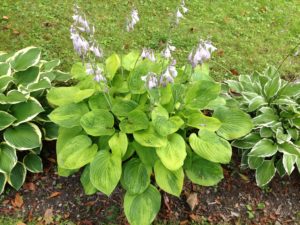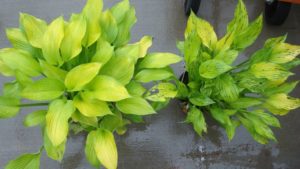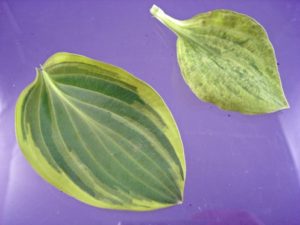Hosta Virus X (HVX) is not a new problem, however, it’s not as prevalent as it was nearly a decade ago because growers have gotten better about recognizing the disease and removing infected plants from their nurseries. The most common symptoms include mottled, light or dark green discolorations along leaf veins (Fig 1). HVX may also be expressed as green and yellow mottling of the leaf blades, puckering, circular discolored areas or twisted leaves. The appearance of symptoms varies widely by cultivar and the color of foliage (Fig 2, 3).
- Figure 1: Hosta virus X infected plant adjacent to healthy plants.
- Figure 2: Hosta August Moon, healthy plant on left with HVX infected plant on right. (A. Windham, University of Tennessee)
- Figure 3: Hosta Golden Tiara, healthy leaf below left with HVX infected leaf upper right. (A. Windham, University of Tennessee)
HVX is not vectored by insects. It is transmitted from plant to plant by contact with infected sap through such activities as dividing or trimming. It doesn’t spread nearly as easily as Tobacco mosaic virus but care should still be taken to disinfest contaminated tools to avoid spread to healthy hosta.
Management:
- Send samples to a diagnostic lab when HVX is suspected
- Remove plants that test positive for HVX
- Disinfest tools that may have been in contact with infected plants
- Check new hosta plants for symptoms before buying and planting
For the home gardener just thoroughly scrubbing tools in hot soapy water should be enough to prevent spreading. Professionals may want to use disinfectants such as Zerotol, KleenGrow, Physan or Virkon after removing all organic matter from tools. When disinfecting the tools, be sure to allow adequate contact time with the disinfectant as indicated on the product label.
Symptomatic plant tissues can be sent to the Purdue Plant and Pest Diagnostic Laboratory (PPDL) for virus testing and identification.
As with many virus diseases of plants HVX won’t kill the plant but it can reduce overall plant vigor and beauty. Unfortunately, there are no known controls for HVX. The only way to get rid of the virus is to remove and destroy the infected plant.


